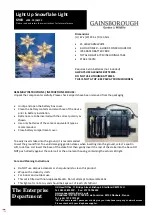
EuroFlow EF and EF/B
Biological Safety Cabinet
UM-EFAB-EN10.doc
51
7
Cleaning
CYTOTOXIC DANGER
When cytotoxics are used, see
§2.5 Cytotoxic danger (EF/B only) on page
10.
Only the responsible safety officer (biological safety officer or the responsible
examiner) can decide if this procedure is valid or not. Additional standard
operation procedures can be necessary.
7.1
Cleaning the installation
The installation has to be cleaned regularly. Preferably, each time after the installation has been
used. Diluted disinfectants may be used. In most cases, hot water with a cleaning agent will be
sufficient.
Chlorine containing cleaning agent is not recommended, because even small concentrations
chlorine may result in an oxidizing effect on the material of the installation.
It is important to clean the worktop (see
§4.6 Worktop on page 15
), the space under the worktop
and drip-trays regularly. A 1% solution of Natriumdodecylsulfat * (SDS-solution CAS-no. 151-21-3)
in demineralised water could be applied for cleaning.
Remove the waste and place it in an appropriate container.
*) Literature:
See Mallinckrodt J.T. Baker data sheet: SDS is MSDS number No S3670
Mallinckrodt Baker Inc. 222 Red School Lane Phillipsburg, NJ 08865
Procedure for cleaning the cabinet
BIOLOGICAL DANGER
Never clean a used installation without precaution
(for instance disinfection)
Switch the installation in the working mode (see
§5.4 Starting up the cabinet on page 26)
;
Put on gloves;
Clean the surface with the SDS-solution on a tissue (Natriumdodecylsulfat solution);
Repeat this action with a new tissue;
Clean the surface with a moist cloth;
Repeat this action;
Dry the surface with a paper tissue.
Cleaning the aerofoil
BIOLOGICAL DANGER
Never take the aerofoil outside a used cabinet
without precaution (for instance disinfection)
















































